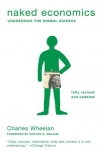Naked Economics Wheelan, Charles (books to read for 13 year olds TXT) 📖

Book online «Naked Economics Wheelan, Charles (books to read for 13 year olds TXT) 📖». Author Wheelan, Charles
Communal resources, on the other hand, present some unique problems. First, the villagers who live in close proximity to these majestic animals usually derive no benefit from having them around. To the contrary, large animals like rhinos and elephants can cause massive damage to crops. To put yourself in the shoes of local villagers, imagine that the people of Africa suddenly took a keen interest in the future of the North American brown rat and that a crucial piece of the conservation strategy involved letting these creatures live and breed in your house. Further imagine that a poacher came along and offered you cash to show him where the rats were nesting in your basement. Hmm. True, millions of people around the world derive utility from conserving species like the black rhino or the mountain gorilla. But that can actually be part of the problem; it is easy to be a “free rider” and let someone else, or some other organization, do the work. Last year, how much time and money did you contribute to preserving endangered species?
Tour and safari operators, who do make a lot of money by bringing wealthy tourists to see rare wildlife, face a similar “free rider” problem. If one tour company invests heavily in conservation, other tour companies that have made no such investment still enjoy all the benefits of the rhinos that have been saved. So the firm that spends money on conservation actually suffers a cost disadvantage in the market. Their tours will have to be more expensive (or they will have to accept a lower profit margin) in order to recoup their conservation investment. Obviously there is a role for government here. But the governments in sub-Saharan Africa are low on resources at best and corrupt and dysfunctional at worst. The one party who has a clear and powerful incentive is the poacher, who makes a king’s ransom by hunting down the remaining rhinos, killing them, and then sawing off their horns.
This is pretty depressing stuff. But economics also offers at least some insight into how the black rhino and other endangered species can be saved. An effective conservation strategy must properly align the incentives of the people who live in or near the black rhino’s natural habitat. Translation: Give local people some reason to want the animals alive rather than dead. This is the premise of the budding eco-tourism industry. If tourists are willing to pay great amounts of money to spot and photograph black rhinos, and, more important, if local citizens somehow share the profits from this tourism, then the local population has a large incentive to keep such animals alive. This has worked in places like Costa Rica, a country that has protected its rain forests and other ecological features by setting aside more than 25 percent of the country as national parks. Tourism currently generates over $1 billion in annual revenue, accounting for 11 percent of the national income.1
Sadly, this process is working in reverse at the moment with the mountain gorilla, another seriously endangered species (made famous by Dian Fossey, author of Gorillas in the Mist). It is estimated that only 620 mountain gorillas are left in the dense jungles of East Africa. But the countries that make up this region—Uganda, Rwanda, Burundi, and Congo—are embroiled in a series of civil wars that have devastated the tourism trade. In the past, local inhabitants have preserved the gorillas’ habitat not because they have any great respect for the mountain gorilla, but because they can make more money from tourists than they can by chopping down the forests that make up the gorillas’ habitat. That has changed as the violence in the region grinds on. One local man told the New York Times, “[The gorillas] are important when they bring in tourists. If not, they are not. If the tourists don’t come, we will try our luck in the forest. Before this, we were good timber cutters.”2
Meanwhile, conservation officials are experimenting with another idea that is about as basic as economics can be. Black rhinos are killed because their horns fetch a princely sum. If there is no horn, then presumably there is no reason to poach the animals. Thus, some conservation officials have begun to capture black rhinos, saw off their horns, and then release the animals back into the wild. The rhinos are left mildly disadvantaged relative to some of their predators, but they are less likely to be hunted down by their most deadly enemy, man. Has it worked? The evidence is mixed. In some cases, poachers have continued to kill dehorned rhinos, for a number of possible reasons. Killing the animals without horns saves the poachers from wasting time tracking the same animal again. Also, there is some money to be made from removing and selling even the stump of the horn. And, sadly, dead rhinos, even without horns, make





Comments (0)